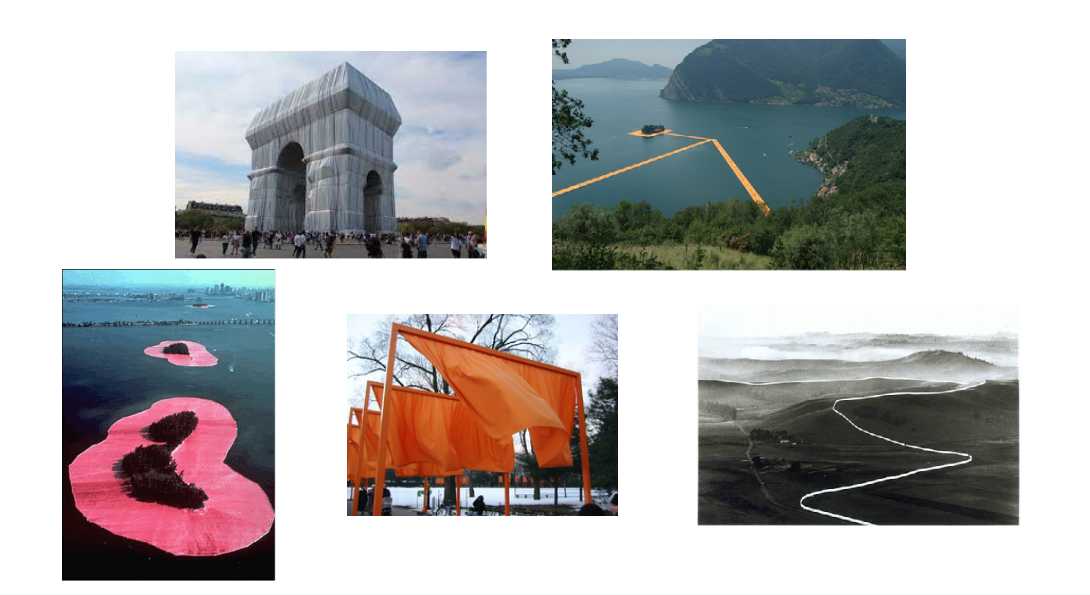11.23.2021- Susy on the Art of Christo and Jeanne Claude
11.23.2021- Susy writes on the Art of Christo and Jeanne-Claude Heading link

Bulgarian artist Christo Vladimirov Javacheff and his French – Moroccan wife, Jeanne Claude, impacted the world with their out-of-the-ordinary, yet aesthetically pleasing art installations, especially in France. Their artistic journey in France began in 1985 when they wrapped the Pont Neuf, the oldest bridge in Paris. Fast forward to more than thirty years later, and they received France’s medal of Commandeur de l’Ordre des Arts et des Lettres (The Order of Arts and Letters), an award given to artists that have contributed to the advancement of art in France. Today, they have made history yet again by covering another Parisian monument, L’arc de Triomphe.
Christo and Jeanne – Claude were known for wrapping objects and other structures worldwide, and one of their aspirations was to cover up the Arc de Triomphe. Unfortunately, both Jeanne – Claude and Christo passed away before starting the project, so Christo’s nephew took over for them this year.
L’Arc de Triomphe originally symbolized the victorious Battle of Austerlitz in 1805. Since then, it has turned into a national symbol of “perseverance” and remembrance, with the names of soldiers and generals written under the Arc. It even serves as the start and endpoint of the famous “Tour de France.” With that said, I asked myself, why would someone want to cover up an iconic national symbol? After some research, I was able to get a better idea of the meaning behind Christo and Jeanne – Claude’s art.
The couple followed in the steps of the “progressive art scenes that were busily exploring all conventions” in the ’60s’. Christo, in particular, started small, wrapping everyday household items, then this fascination grew bigger. Eventually, his wife helped him wrap structures and even bodies of water (pictures 2 & 3). Yes, you read that correctly; see “The Floating Piers” and “Surrounding Islands.”
At first, the couple focused on the physicality of wrapping, the twists, turns, and textures of the items. They wanted to strip the meaning and draw attention solely to the shape “to preserve them permanently for posterity.” The idea of removing the meaning is interesting because it allows the spectators to focus on the beauty of the art. With that said, I found “The Gates” (2005) (picture 4) fascinating, a piece in Central Park in New York. Here, Christo and Jeanne – Claude decorated 7 thousand + gates in orange silk. The curtains added an amusing pop of color to the white snow-covered trees in the winter. I enjoyed the fact that the contrasting colors made an already beautiful scenery even more appealing.
Christo and Jeanne – Claude also created “Running Fence” (picture 5) in 1976. This installation covered 24.5 miles of fences across 59 different properties by Freeway 101 in San Francisco, California. The design reminded me of the Great Wall of China because the fences appeared to be more than abandoned wire in an open field. The white fabric emphasized them and made it seem like a winding road, never-ending and moving along the hills. I loved how Christo and Jeanne – Claude gave life to a bland and empty piece of land.
In the end, I would like to think that I understood why Christo wanted to wrap the Arc de Triomphe. The “25,000 square [meters] of silver-blue fabric” erases history for one second, which I know is abstractly impossible, but think about it. When that fabric covers up the Arc, it makes you forget about what the monument was and makes you think about what it has become.
However, we can also argue that keeping the structure intact does the same for the history behind the monument. In a way, covering up the Arc the Triomphe was a symbol of preserving the identity of France and the spirit of those lost during battle, keeping that history rooted within France.
In the end, it is incredible how simple layers of fabric made people think more critically about what “wrapping” means, as I did. Nonetheless, ironically, sometimes, the purpose of changing a structure’s appeal is that it simply catches the eye and looks fascinating, which could be the case of the Arc de Triomphe. I guess that is the complex nature of art; it paves the way to reimagine and create our interpretations.
What is your take on Christo and Jeanne – Claude’s art?
-Susy 🙂